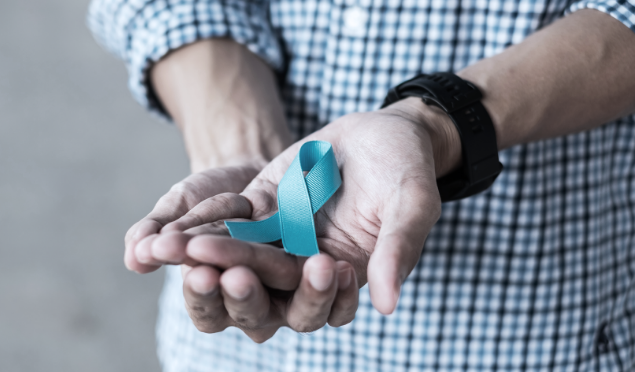#Movember: What we all need to know about men’s health

Published on 24th October, 2019 at 11:31 am
South African men face a one in 19 lifetime risk for prostate cancer, while the odds of developing testicular cancer are less, at one in 2 084.
Besides this, statistics show a concerning state of mental health among men. 2016 Figures from the South African Depression and Anxiety Group (SADAG) show that the prevalence of suicide is four times higher in men than in women, with 14 to 18 men taking their lives every day in South Africa, according to Men’s Health Foundation.
The numbers are overwhelming, but empower us to take charge of health issues facing thousands of men globally. With a proactive approach, men can take back their physical and mental health by empowering themselves with the facts.
Testicular cancer
What’s my risk?
This is the most common cancer in men between the ages of 15-49, according to CANSA. Added to this, Cape Town urologist Dr Ernst De Wet says the risk largely involves uncontrollable factors – i.e., family history, previous cancer in the other testis, Caucasian ethnicity (though this is changing), HIV and a history of undescended testis.
“The risk becomes less if an undescended testis is brought down with a surgical procedure earlier in life,” he explains. “However, these patients still have an increased risk for developing testicular cancer in both testicles.”
Contrary to popular belief, injury is not the cause of testicular cancer, says Dr Guy Parr, a Cape Town family physician.
How can I check myself?
Starting in their teenage years, men should make a habit of keeping an eye out for a painless lump in the testis and/or testicular swelling, and do monthly self-examinations.
“Testicular cancer is probably the cancer where self-examination has the most value,” encourages Dr De Wet. “Monthly self-examination, even assisted by one’s partner, can pick up many small lumps early and prompt further investigation.” He also suggests comparing the testicles to one another and paying attention to any discrepancy in size, contour or consistency.
For a guide to testicular self-examination, click here. If you have any concerns, make an appointment with your GP as soon as possible.
Signs that the disease has advanced further include shortness of breath, weight loss, abdominal pain and gynecomastia (a condition where men develop female-like breasts).
I’ve been diagnosed – now what?
There’s a reason it’s known as the dreaded “c-word”, but the good news is that the prognosis is quite positive: “More than 95% of all patients diagnosed with testicular cancer survive their disease,” reassures Dr De Wet. “Even patients with stage 3 disease have a decent chance of survival with a combination of surgery and chemotherapy with or without radiotherapy,” he continues.
Can you have children after treatment? Yes, if you follow the right precautions: “Treatment with surgery, radiation or chemotherapy can reduce or eliminate sperm production, causing infertility,” says Dr De Wet. “It is recommended that a patient should store sperm prior to the start of treatment for testicular cancer.” Even if this precaution isn’t taken, a man could still father a child after treatment, depending on the type and amount of treatment used.
Prostate cancer
How can I manage my risk?
The popular belief is that prostate cancer is a grandpa’s disease. “Not true,” says Dr Parr. “This is increasingly common in men from their late 40s onwards.” Family history – especially diagnoses in first-degree relatives – has an influence too, and this isn’t limited to prostate cancer diagnoses, as Dr De Wet explains: “Men with female relatives with breast cancer related to the breast cancer gene (BRCA) are also at a higher risk.”
Local data connecting the prevalence of diagnoses to South African ethnicities is scarce, but it suggests that black men are at a higher risk for this type of cancer.
Lifestyle changes could lower your chances of developing the disease. According to the World Health Organization, a diet high in red meat and processed meat (and low in vegetables) can increase your risk for prostate cancer.
How is it diagnosed?
Upon hearing “prostate check”, most men think “rectal exam”. But this isn’t necessarily the case, as Dr Parr explains: “Screening for prostate cancer is largely done with a blood test nowadays. Most men would rather jump off a cliff than have a rectal exam. Luckily, this is largely unnecessary, and a patient is allowed to decline to have a rectal exam.” With that said, men should bear in mind that the digital rectal exam brings unique value in management of the disease, says Dr De Wet. Yes, it can be awkward and uncomfortable, but this isn’t always necessarily the case, as he explains: “By far the majority of patients report only mild discomfort. It is a quick test, and with enough lubrication, should hardly be troublesome.”
The question to ask yourself is: would you rather experience a moment of discomfort now in exchange for peace of mind, or delay and deal with the long-term consequence down the line?
I’ve been diagnosed – now what?
This one could surprise you. While treatment options include surgery, radiotherapy, hormonal treat or a combination of these, Dr De Wet says not all diagnosed patients need active treatment. Why? “These options are associated with significant morbidity,” he says. “This includes erectile dysfunction and problems with urination.”
The two management options he lists are:
- Watchful waiting
“In this scenario, the treating doctor would observe that the cancer will probably progress very slowly and that the patient is unlikely to die because of the cancer.”
- Active surveillance
“This approach is reserved for fit and healthy patients with a good life expectancy and a low-risk prostate cancer. They get followed up regularly to determine when the cancer is becoming more aggressive, at which stage the patient will require active curative treatment.”
Check the health of your cover, too
Severe illness cover typically includes cancer cover, says Karen Bongers, product development actuary at Sanlam Individual Life. “Sanlam also offers a standalone Cancer benefit. Prostate cancer is the cancer most often diagnosed in South African men, so all men would be wise to opt for cover in this regard. Most of these benefits will cover advanced prostate cancer, but if cover for earlier stages of prostate cancer is also required, one must ensure that the benefit being selected does cover early prostate cancer. As such, cover is not necessarily standard.”
Very early prostate cancers may not be covered, or have a small payout percentage, with the payout percentage increasing up to 100% as the stage progresses, she continues.
Remember: Sanlam Reality members get up to 30% off Sanlam risk products.
Mental health & suicide prevention
In South Africa, three quarters of suicides are committed by men, many of whom suffer from untreated depression, says Linda Da Silva, a Jo’burg psychologist. The perception that women are more emotional, and therefore are more open to addressing their mental health problems, is a construct that needs to be challenged – especially to open doors for men to acknowledge their challenges and seek treatment.
“In my view, a key difference is not that men do not suffer as much from depression as women,” says Da Silva. “Rather, it is just that they do not tend to talk about it in the same way, and are less likely to present for treatment and therefore be diagnosed.” Depression should be taken as seriously as any other health condition. “It is a medical condition, not a weakness, and needs to be seen as a response to a number of stressful factors,” says Dr Parr.
Dr Parr and Da Silva suggest keeping an eye out for the following signs:
- Irritability (“Women tend to get sad, men tend to get irritable,” notes Dr Parr)
- Social withdrawal
- Sleep problems
- Increased alcohol consumption (“self-medicating,” says Da Silva)
- Becoming abusive, controlling and/or violent (“Possibly due to a build-up of feelings of helplessness, or a maladaptive response to loss of a sense of agency/potency in the world,” suggests Da Silva)
- An increase in physical risk-taking behaviour such as aggressive driving or unsafe sex
“Pay attention to your body’s physiological and emotional signals, and start talking about what you notice, especially to your doctor or healthcare practitioner,” says Da Silva. Seeking help is daunting for many men, especially the prospect of speaking to a psychologist – but it needn’t be. “A good GP should be able to look at the whole patient, not just a part, and will be able to recognise the symptoms of depression during a check-up,” assures Dr Parr.
Check the health of your cover, too
If you’re on private medical aid, by law you are entitled to 15 sessions of psychotherapy for depression, irrespective of the scheme you are on, says Da Silva. “Ask your health practitioner to assist you in completing a Prescribed Minimum Benefits (PMB) form,” she encourages.
Read more about these here. For those using government healthcare, treatment for depression is available at primary healthcare clinics.
When it comes to risk cover, Bongers says certain comprehensive severe illness benefits cover mental health conditions, but typically to a limited extent. “A wider range of these conditions could be covered by disability benefits, if a condition results in the inability to perform one’s occupation,” she says.
Sanlam Reality members get up to 30% off Sanlam risk products.
Click here to book a meeting with a financial planner to find the right risk cover for you.
Want to learn more?
We send out regular emails packed with useful advice, ideas and tips on everything from saving and investing to budgeting and tax. If you're a Sanlam Reality member and not receiving these emails, update your contact details now.
Update Now







